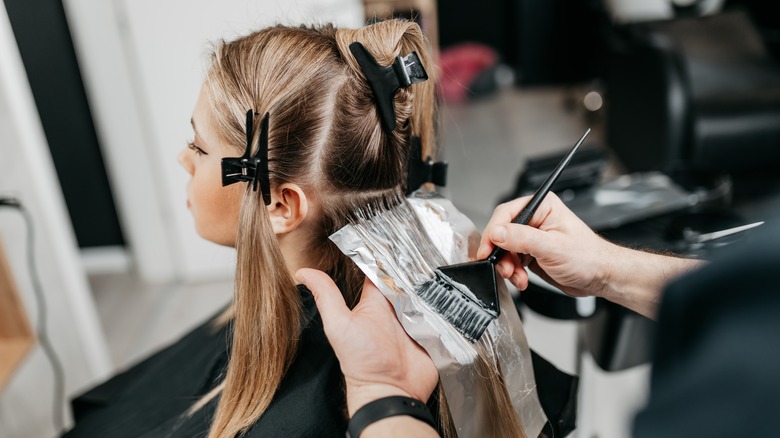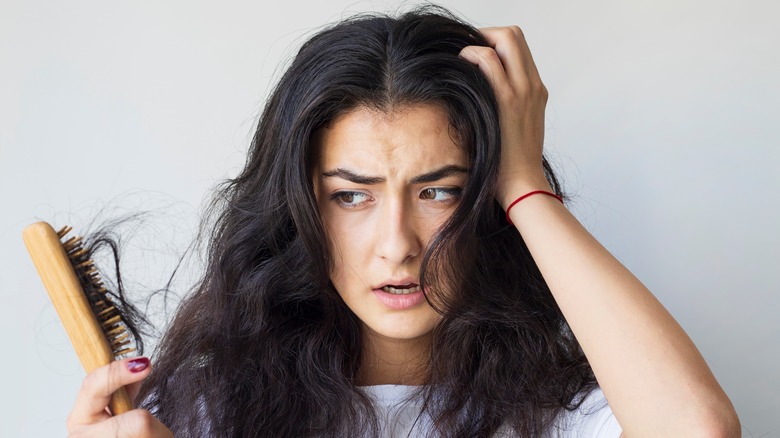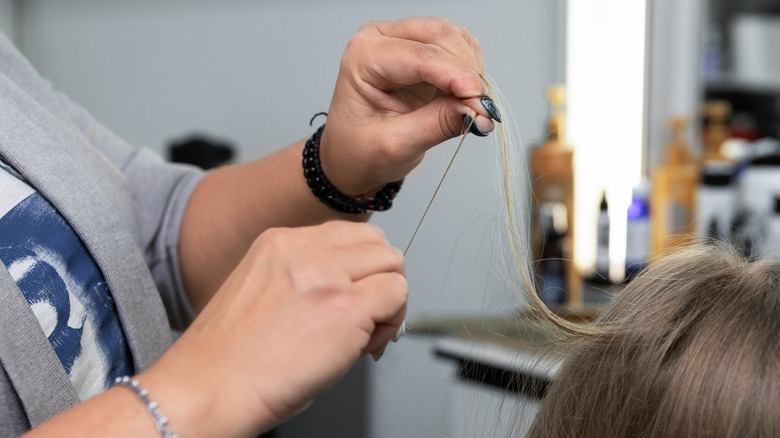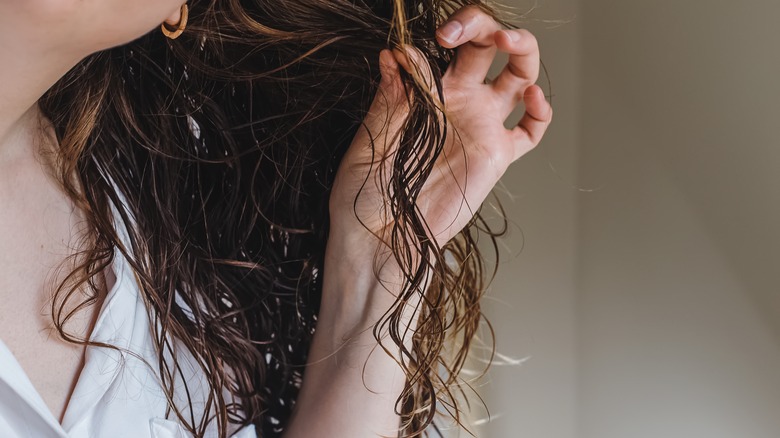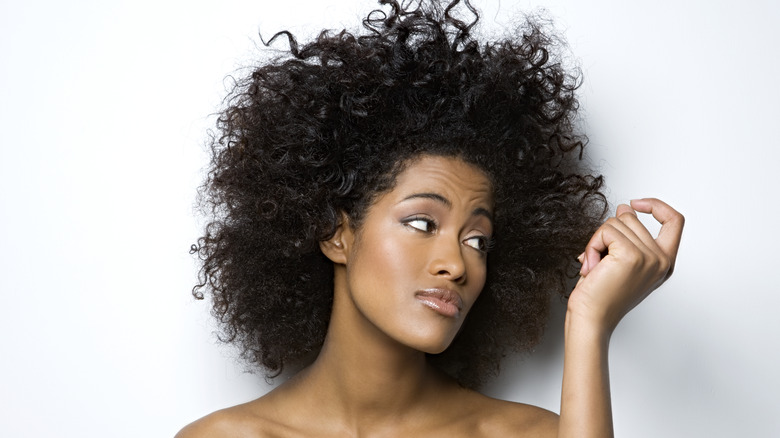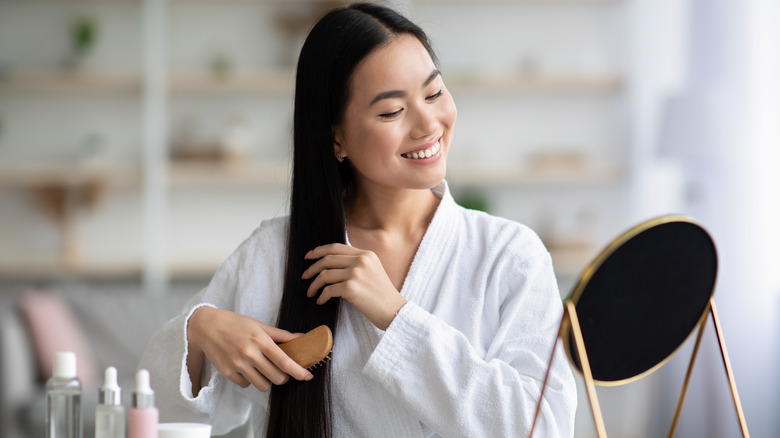Red Flags That You Should Keep Your Hair Healthy By Not Bleaching It
Bleaching your hair is a long process that takes a toll on your mane. If it's already in poor condition, lightening it will only cause more damage and breakage. Bleach works by raising the cuticle and oxidizing the pigment in your hair shaft, according to Philip Kingsley. It's usually made from a mix of hydrogen peroxide and ammonia.
Continually using bleach affects your hair's protein structure and ability to hold moisture. It causes the cuticle to remain open, which results in your mane becoming more porous. When it comes time to style your hair, tools like blow dryers and straighteners can create frizz and split ends. Even the environment can easily damage your hair if it's sunny, rainy, or windy outside. Bleach is safe to use if you don't overdo it. Using the right volume developer and limiting the number of sessions can keep your hair as healthy as possible. Making sure your tresses are in good shape is also necessary for good results and not hair loss.
Split ends and hair loss
Your hair can be damaged for several reasons, but if you're thinking about bleaching it while it's in this state, it will only give you more problems. The easiest way to see if it's healthy to process is by simply looking at it. The biggest red flag is a crispy look — even though you didn't use any hot tools to style your hair. Your air-dried mane may also look frizzy from split ends and flyaways, according to Wella Professionals.
Do you notice your hair is always tangled when you brush it? Unruly strands that are hard to tame are another sign of damage. They may even break and feel brittle as you try to use the brush. All of these characteristics are red flags that your hair isn't healthy. Getting it bleached when it's like this will most likely lead to strands breaking and falling out. The following tests can help you determine what's wrong with your hair and how to repair it. Only then should you bleach it.
Compromised cuticle
Checking the health of your cuticle is essential for deciding if your hair is healthy enough to bleach. Lightening treatments can harm this part of your hair, so it's important to ensure they're not already damaged. Madison Reed explains that, first, choose a strand of hair. Then, pull it so it's taut, but not too hard — it should not come out of your scalp. Take a drop of water and place it on the strand, counting how long it takes before your hair absorbs it.
The longer it takes for the water to penetrate your hair, the better. This is because you want a sealed cuticle that protects every strand. When it's compromised, water is quickly absorbed. The exact time you're looking for is 10 seconds or less — any quicker than that, and you should stay away from bleach. While your hair is wet, pull it a bit to test its elasticity. The strand being overly stretchy when moist is another sign that your cuticle is damaged.
Protein damage
A healthy head of hair is packed with protein. Each strand needs this essential component to keep its shape, structure, and strength. Without it, your hair may look dull, limp, and stringy. You can stretch a piece to test if you're missing protein — pick up a single strand of hair, and hold it at the root and the end. Then, pull it gently from both sides, looking to see how much it stretches.
If the piece of hair breaks, you likely have protein damage, according to L'Oréal Professionnel Paris. You should also check how the strand looks after you release it — a healthy strand will return to its original state after the test. It could also curl or stay elongated, which is an indicator that it's lacking moisture. Another way to check for protein damage involves feeling the surface of your hair. Pick up a small section of hair and pull it slightly. Then, run your fingers over it to feel the texture. If it feels uneven or pieces start to break off, it's too damaged to bleach.
Low porosity hair
The porosity of your hair matters when it comes to bleaching. It's important to know how porous yours is for many different reasons. Other than trying to do lightening treatments, it can help you choose more effective hair care products, like conditioners. Doing a porosity test measures how effectively your mane absorbs moisture, which can affect the bleaching process. Botox Capilar Hair Professionals explain that bleach can't penetrate the hair as easily when it's low. If it's high, your strands need more moisture before going through a lightening process.
To find out what your hair's porosity is, you'll need a cup of water and a strand. Ensure that the piece is freshly washed and has no products on it. Place it in the water and watch where it moves. Hair with normal porosity will stay in the middle of the cup or slowly move to the bottom, according to Curl Smith. When it sinks almost immediately to the bottom, it is high. You have low porosity hair if it stays floating at the top of the glass.
How to achieve healthy hair
Having healthy hair is essential if you want to bleach it. It's an intense process that puts each strand under pressure with strong products. The chemicals in hair bleach can do a lot of damage if they're used incorrectly or too often. Hair by L'Oréal explains that it's impossible to completely repair your mane once it's been damaged by bleach. However, you can use products that help it feel and look healthy as possible until you trim all of the broken ends — this is why regular haircuts are the key to this process.
The products you use also play a part in your hair's health. When you're routinely bleaching it, you can easily lose protein. You can add it back by incorporating a bonding treatment into your routine, as well as a weekly hair mask. You should also keep your shower water at a mild temperature — setting it too hot will draw the moisture out of your hair. It's ideal to end every shower with a cold rinse to ensure that your hair cuticle is sealed. Staying away from hot tools is another important step in returning your hair to a healthy state.
